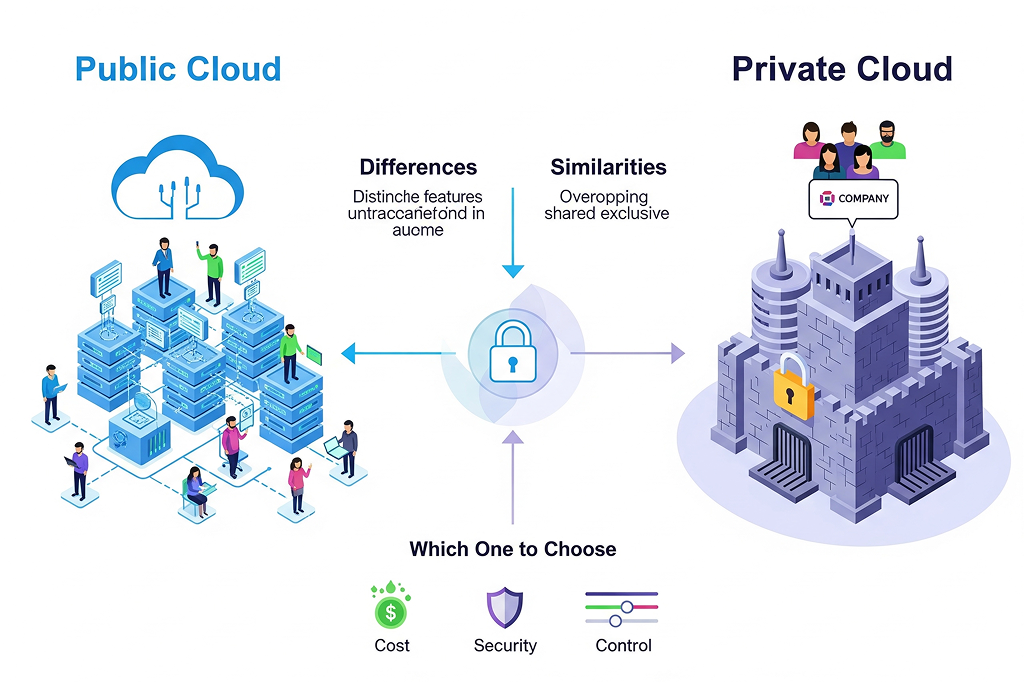Public Cloud vs Private Cloud: Differences, Similarities, and Which One to Choose

Cloud environments can be divided into two broad categories: public cloud and private cloud. The biggest difference between these two is how organizations access the network or services.
In a public cloud, a shared cloud infrastructure is used by a company, provided by a third party, whereas in a private cloud, a company uses its own infrastructure.
This guide will help you understand the difference between the two with an in-depth comparison and help you choose the right cloud infrastructure for your business.
NOTE: There are two additional types, i.e., hybrid and multi-cloud. However, in this blog, we’ll only focus on public and private clouds.
Key Takeaways
|
What Is “The Cloud” in Cloud Computing?
In simple terms, the cloud refers to a network of remote servers hosted on the Internet that store, manage, and process data instead of using local servers or personal computers.
What is Public Cloud?
It is a cloud computing environment where third-party providers offer services to multiple customers over the public or shared Internet. In this model, the cloud provider owns and operates the infrastructure (data centers, servers, networks, etc.) and delivers these resources as a fully managed service to multiple users referred to as tenants. This means many tenants share the same hardware resources, while their data and workloads remain logically isolated. Public cloud services are typically delivered on a pay-as-you-go or subscription model, allowing users to scale usage up or down easily.
Examples of Public Cloud: Amazon Web Services (AWS), Microsoft Azure, and Google Cloud Platform (GCP)
Public Cloud Service Model
Public cloud services generally come in three main models, depending on what is offered as a service:
- Infrastructure as a Service (IaaS): In this, the provider supplies fundamental IT resources like virtual servers, storage, and networks on demand, while customers manage the software (OS, applications) but not the underlying cloud hardware. For instance, AWS Elastic Compute Cloud (EC2) virtual servers.
- Platform as a Service (PaaS): The provider delivers a ready-to-use platform (hardware + operating system + necessary frameworks) for customers to develop and run applications without worrying about lower-level details. Think of Google App Engine or Azure App Service for web apps.
- Software as a Service (SaaS): Finally, in SaaS, the provider hosts complete applications accessible to users via the internet (usually a web browser). Everything else is managed by the provider. Take the example of Microsoft 365, where users simply use the software online and do not manage servers.
NOTE: While SaaS can be delivered via public or private clouds, the most common SaaS offerings are on public cloud infrastructure.
Advantages of Public Cloud
- Cost Savings & No Upfront Capital: Public cloud eliminates the huge capital expense of buying hardware and building data centers. Companies can start projects without a large upfront investment, paying only for what they use on a monthly basis. This is ideal for startups or projects where demand is uncertain.
- Minimal Maintenance: Since the cloud provider handles all the infrastructure maintenance, businesses can rely on small IT teams to leverage world-class infrastructure without having to manage it physically.
- Scalability & Flexibility: Public cloud resources are practically unlimited from a customer perspective. If your application needs to handle a sudden surge in traffic, you can rapidly scale up servers or throughput. Cloud providers have massive data centers to allocate capacity on demand.
- Global Reach: The major public clouds have data centers all around the world. This allows organizations to deploy applications closer to end-users for better performance and to have redundancy across geographies.
- Access to Cutting-Edge Technology: Public cloud platforms offer a vast array of the latest services and tools. For example, AWS, Azure, and GCP provide services in artificial intelligence, machine learning, big data analytics, Internet of Things (IoT), serverless computing, and more – all readily available to use without having to install anything on-premise.
What is Private Cloud?
This is a cloud computing environment that is used exclusively by one organization, and the infrastructure is either hosted on-premises within the organization’s own data center or on dedicated hardware at a third-party hosting facility. In both cases, the resources are not shared with any other organization.
Essentially, it’s an isolated cloud environment behind a company’s firewall or on a private network, offering cloud benefits (such as virtualization, scalability, self-service) but with greater control and privacy.
In a private cloud, the enterprise or a contracted vendor is responsible for managing and maintaining the cloud infrastructure.
It’s important to note that while a private cloud implements cloud computing technologies such as virtual machines and containers, it does so on proprietary infrastructure for one user. This is different from a traditional on-premises IT setup in that a private cloud still employs the cloud principles of elastic resource pooling and on-demand provisioning. However, all users in a private cloud belong to the same organization, and no external customers share that hardware.
Examples of Private Cloud: Microsoft Azure Stack, allowing organizations to run a version of Azure services on their own hardware. Another example is using OpenStack, an open-source cloud platform, to deploy a private cloud on-premises
Advantages of Private Cloud
- Exclusive Use of Resources (Privacy): Since a private cloud is not shared with any other organization, it offers inherent data isolation and privacy. A single tenant has complete use of the hardware, which can reduce concerns about data co-mingling or accidental access by others.
- Greater Control & Customization: The business has full control over the cloud environment. This means they can customize network architecture, storage configurations, and software installations to meet their needs.
- High Security and Compliance: Because it’s an isolated environment, the risk of external threats can be minimized (though not eliminated – internal threats or misconfigurations can still cause breaches). For industries under heavy compliance regulations (healthcare, finance, government), a private cloud can be configured to meet those exact regulations. For example, certain government workloads require FedRAMP High or ITAR compliance, which might only be achievable in a private cloud or a specialized gov cloud.
- Performance and Low Latency: When properly designed, a private cloud can deliver very high performance. Since it is a single-tenant environment, there’s no sharing of CPU, memory, or disk I/O with external parties, resulting in extremely low latency, ideal for real-time applications.
Public Cloud vs Private Cloud: Key Differences
| Aspect | Public Cloud | Private Cloud |
| Ownership & Hosting | A third-party provider owns and operates the infrastructure. Resources are in provider-operated data centers. | The infrastructure is owned or leased by a single organization. Resources are on-site at the company’s own facilities or in a colocation center. |
| Access & Multi-tenancy | A multi-tenant environment where multiple customers share a pool of resources. Each customer’s data and workloads are isolated virtually. | A single-tenant environment used exclusively by one organization or a specific group. Access is behind the company’s firewall. |
| Control & Customization | Users control the software level (apps, data). The underlying infrastructure is standardized and controlled by the provider. | The organization has greater control over hardware, network topology, security settings, and other configurations. |
| Scalability | Near-infinite and rapid scalability. Resources can be provisioned with a few clicks from a massive global pool. | Scalability is limited by the owned infrastructure. Scaling may require purchasing and installing new hardware, which takes time. |
| Cost Structure | A pay-as-you-go utility model. It involves no large upfront capital expenditure (CapEx) but has ongoing operational expenses (OpEx). | Significant upfront capital investment (CapEx) for hardware and setup, with ongoing costs for maintenance and staff. |
| Maintenance & Staffing | The provider handles all physical infrastructure maintenance, updates, and patching. The user focuses on their applications. | The organization is responsible for all maintenance, requiring skilled in-house IT personnel or a hired managed service. |
| Security & Compliance | Security is a shared responsibility: the provider secures the infrastructure, and the customer secures their data and applications. Providers invest heavily in robust security features and certifications. | Provides isolation by default, as only one organization’s data is on the infrastructure. The organization has full control over security measures and compliance. |
| Performance | Powerful but can be subject to “noisy neighbor” effects in a multi-tenant environment. Latency may be higher as it requires traversing the Internet. | Predictable, high performance without the “noisy neighbor” effect. It can be optimized for specific workloads and offers low latency on a private network. |
| Elasticity & Resource Utilization | High elasticity allows resources to scale up and down automatically to match demand. This avoids over-provisioning and leads to higher utilization. | Elasticity is limited to owned resources. Companies often over-provision for peak usage, leading to underutilization during low-demand periods. |
To sum up, the critical difference is that a public cloud is hosted and managed by an outside provider and shared among multiple users, whereas a private cloud is hosted either on-premises or on dedicated gear and used by a single organization. Everything else, like cost, control, security responsibilities, and scalability, flows from that fundamental distinction.
Similarities between Public and Private Cloud
Although public and private clouds differ in ownership and accessibility, they do share some important characteristics.
- On-demand Resources: Both provide rapid provisioning without manual hardware setup.
- Virtualization: Both are built on virtualization technologies to abstract physical hardware.
- Scalability: Both allow scalability; however, the scopes are different.
- Automation: Both rely on automation to improve efficiency.
How to Choose the Right Cloud Environment?
While it depends on the organization’s requirements, budget, and strategic goals, here are some considerations to help choose:
Use Public Cloud When:
- Your workloads are variable or unpredictable (e.g., an e-commerce site with seasonal spikes, or a mobile app that could go viral), the elasticity of public cloud is invaluable.
- Your team is small or lacks deep IT infrastructure expertise, so letting the cloud provider handle the heavy lifting can accelerate development and deployment.
Public Cloud is Ideal for:
- Startups
- Small-to-medium businesses
- New projects
Use Private Cloud When:
- Data security, compliance, or performance requirements outweigh the benefits of public cloud. For example, if you handle regulated data (health records under HIPAA, credit card data under PCI-DSS, government classified data), and the regulators or your risk management team require full control over the environment, a private cloud might be non-negotiable.
- Your operations are in a location with poor Internet connectivity.
- Your organization requires specialized hardware.
Private Cloud is Ideal for:
- Large enterprises
- Businesses that already have data center infrastructure
NOTE: Depending on the requirement, organizations use a combination of both private and public clouds, which is also referred to as a hybrid cloud.
Final Words
Both private and public clouds are integral to cloud computing. Where public cloud is ideal for small businesses and startups, private cloud is an ideal choice for large-scale businesses.
From a career standpoint, cloud computing is a dynamic field, and whether you work with AWS public cloud resources or architect a private cloud solution for a company, you are dealing with technologies at the forefront of IT.
To become a professional in this niche, enroll in the CCI Training Center’s Cloud Computing or Computer Network Technician Training Programs.
Program Offered
- Pharmacy Technician Training
- Online Medical Assistant
- Medical Billing and Coding Specialist Program
- Cloud Computing Technician Training
- Computer Network Technician
- Business and Accounting
- Radiology Technician Training
- Medical Assistant Program
- Computer Support Technician
- Cybersecurity Program
- Virtual Assistant Training

This article is written by
Share this article

Key Takeaways
|
What Is “The Cloud” in Cloud Computing?
In simple terms, the cloud refers to a network of remote servers hosted on the Internet that store, manage, and process data instead of using local servers or personal computers.What is Public Cloud?
It is a cloud computing environment where third-party providers offer services to multiple customers over the public or shared Internet. In this model, the cloud provider owns and operates the infrastructure (data centers, servers, networks, etc.) and delivers these resources as a fully managed service to multiple users referred to as tenants. This means many tenants share the same hardware resources, while their data and workloads remain logically isolated. Public cloud services are typically delivered on a pay-as-you-go or subscription model, allowing users to scale usage up or down easily. Examples of Public Cloud: Amazon Web Services (AWS), Microsoft Azure, and Google Cloud Platform (GCP)Public Cloud Service Model
Public cloud services generally come in three main models, depending on what is offered as a service:- Infrastructure as a Service (IaaS): In this, the provider supplies fundamental IT resources like virtual servers, storage, and networks on demand, while customers manage the software (OS, applications) but not the underlying cloud hardware. For instance, AWS Elastic Compute Cloud (EC2) virtual servers.
- Platform as a Service (PaaS): The provider delivers a ready-to-use platform (hardware + operating system + necessary frameworks) for customers to develop and run applications without worrying about lower-level details. Think of Google App Engine or Azure App Service for web apps.
- Software as a Service (SaaS): Finally, in SaaS, the provider hosts complete applications accessible to users via the internet (usually a web browser). Everything else is managed by the provider. Take the example of Microsoft 365, where users simply use the software online and do not manage servers.
Advantages of Public Cloud
- Cost Savings & No Upfront Capital: Public cloud eliminates the huge capital expense of buying hardware and building data centers. Companies can start projects without a large upfront investment, paying only for what they use on a monthly basis. This is ideal for startups or projects where demand is uncertain.
- Minimal Maintenance: Since the cloud provider handles all the infrastructure maintenance, businesses can rely on small IT teams to leverage world-class infrastructure without having to manage it physically.
- Scalability & Flexibility: Public cloud resources are practically unlimited from a customer perspective. If your application needs to handle a sudden surge in traffic, you can rapidly scale up servers or throughput. Cloud providers have massive data centers to allocate capacity on demand.
- Global Reach: The major public clouds have data centers all around the world. This allows organizations to deploy applications closer to end-users for better performance and to have redundancy across geographies.
- Access to Cutting-Edge Technology: Public cloud platforms offer a vast array of the latest services and tools. For example, AWS, Azure, and GCP provide services in artificial intelligence, machine learning, big data analytics, Internet of Things (IoT), serverless computing, and more – all readily available to use without having to install anything on-premise.
What is Private Cloud?
This is a cloud computing environment that is used exclusively by one organization, and the infrastructure is either hosted on-premises within the organization’s own data center or on dedicated hardware at a third-party hosting facility. In both cases, the resources are not shared with any other organization. Essentially, it’s an isolated cloud environment behind a company’s firewall or on a private network, offering cloud benefits (such as virtualization, scalability, self-service) but with greater control and privacy. In a private cloud, the enterprise or a contracted vendor is responsible for managing and maintaining the cloud infrastructure. It’s important to note that while a private cloud implements cloud computing technologies such as virtual machines and containers, it does so on proprietary infrastructure for one user. This is different from a traditional on-premises IT setup in that a private cloud still employs the cloud principles of elastic resource pooling and on-demand provisioning. However, all users in a private cloud belong to the same organization, and no external customers share that hardware. Examples of Private Cloud: Microsoft Azure Stack, allowing organizations to run a version of Azure services on their own hardware. Another example is using OpenStack, an open-source cloud platform, to deploy a private cloud on-premisesAdvantages of Private Cloud
- Exclusive Use of Resources (Privacy): Since a private cloud is not shared with any other organization, it offers inherent data isolation and privacy. A single tenant has complete use of the hardware, which can reduce concerns about data co-mingling or accidental access by others.
- Greater Control & Customization: The business has full control over the cloud environment. This means they can customize network architecture, storage configurations, and software installations to meet their needs.
- High Security and Compliance: Because it’s an isolated environment, the risk of external threats can be minimized (though not eliminated – internal threats or misconfigurations can still cause breaches). For industries under heavy compliance regulations (healthcare, finance, government), a private cloud can be configured to meet those exact regulations. For example, certain government workloads require FedRAMP High or ITAR compliance, which might only be achievable in a private cloud or a specialized gov cloud.
- Performance and Low Latency: When properly designed, a private cloud can deliver very high performance. Since it is a single-tenant environment, there’s no sharing of CPU, memory, or disk I/O with external parties, resulting in extremely low latency, ideal for real-time applications.
Public Cloud vs Private Cloud: Key Differences
| Aspect | Public Cloud | Private Cloud |
| Ownership & Hosting | A third-party provider owns and operates the infrastructure. Resources are in provider-operated data centers. | The infrastructure is owned or leased by a single organization. Resources are on-site at the company’s own facilities or in a colocation center. |
| Access & Multi-tenancy | A multi-tenant environment where multiple customers share a pool of resources. Each customer’s data and workloads are isolated virtually. | A single-tenant environment used exclusively by one organization or a specific group. Access is behind the company’s firewall. |
| Control & Customization | Users control the software level (apps, data). The underlying infrastructure is standardized and controlled by the provider. | The organization has greater control over hardware, network topology, security settings, and other configurations. |
| Scalability | Near-infinite and rapid scalability. Resources can be provisioned with a few clicks from a massive global pool. | Scalability is limited by the owned infrastructure. Scaling may require purchasing and installing new hardware, which takes time. |
| Cost Structure | A pay-as-you-go utility model. It involves no large upfront capital expenditure (CapEx) but has ongoing operational expenses (OpEx). | Significant upfront capital investment (CapEx) for hardware and setup, with ongoing costs for maintenance and staff. |
| Maintenance & Staffing | The provider handles all physical infrastructure maintenance, updates, and patching. The user focuses on their applications. | The organization is responsible for all maintenance, requiring skilled in-house IT personnel or a hired managed service. |
| Security & Compliance | Security is a shared responsibility: the provider secures the infrastructure, and the customer secures their data and applications. Providers invest heavily in robust security features and certifications. | Provides isolation by default, as only one organization’s data is on the infrastructure. The organization has full control over security measures and compliance. |
| Performance | Powerful but can be subject to “noisy neighbor” effects in a multi-tenant environment. Latency may be higher as it requires traversing the Internet. | Predictable, high performance without the “noisy neighbor” effect. It can be optimized for specific workloads and offers low latency on a private network. |
| Elasticity & Resource Utilization | High elasticity allows resources to scale up and down automatically to match demand. This avoids over-provisioning and leads to higher utilization. | Elasticity is limited to owned resources. Companies often over-provision for peak usage, leading to underutilization during low-demand periods. |
Similarities between Public and Private Cloud
Although public and private clouds differ in ownership and accessibility, they do share some important characteristics.- On-demand Resources: Both provide rapid provisioning without manual hardware setup.
- Virtualization: Both are built on virtualization technologies to abstract physical hardware.
- Scalability: Both allow scalability; however, the scopes are different.
- Automation: Both rely on automation to improve efficiency.
How to Choose the Right Cloud Environment?
While it depends on the organization’s requirements, budget, and strategic goals, here are some considerations to help choose:Use Public Cloud When:
- Your workloads are variable or unpredictable (e.g., an e-commerce site with seasonal spikes, or a mobile app that could go viral), the elasticity of public cloud is invaluable.
- Your team is small or lacks deep IT infrastructure expertise, so letting the cloud provider handle the heavy lifting can accelerate development and deployment.
- Startups
- Small-to-medium businesses
- New projects
Use Private Cloud When:
- Data security, compliance, or performance requirements outweigh the benefits of public cloud. For example, if you handle regulated data (health records under HIPAA, credit card data under PCI-DSS, government classified data), and the regulators or your risk management team require full control over the environment, a private cloud might be non-negotiable.
- Your operations are in a location with poor Internet connectivity.
- Your organization requires specialized hardware.
- Large enterprises
- Businesses that already have data center infrastructure
Final Words
Both private and public clouds are integral to cloud computing. Where public cloud is ideal for small businesses and startups, private cloud is an ideal choice for large-scale businesses. From a career standpoint, cloud computing is a dynamic field, and whether you work with AWS public cloud resources or architect a private cloud solution for a company, you are dealing with technologies at the forefront of IT. To become a professional in this niche, enroll in the CCI Training Center’s Cloud Computing or Computer Network Technician Training Programs.Program Offered
- Pharmacy Technician Training
- Online Medical Assistant
- Medical Billing and Coding Specialist Program
- Cloud Computing Technician Training
- Computer Network Technician
- Business and Accounting
- Radiology Technician Training
- Medical Assistant Program
- Computer Support Technician
- Cybersecurity Program
- Virtual Assistant Training

This article is written by
Share this article
Frequently Asked Questions FAQ's
Why do companies opt for private clouds?
The primary reasons include:
- Greater control over data
- Customization of the environment
- Enhanced security and privacy
Because the infrastructure is dedicated, the organization can tailor configurations to exact needs and strict policies. For example, if a company must comply with specific data sovereignty laws or security standards, keeping workloads on a private cloud may simplify compliance.
Can the public and private clouds be used together?
Absolutely! A majority of organizations use a hybrid cloud environment as per their needs. In this, the company’s IT resources can be integrated with third-party cloud providers’ infrastructure.
Is it possible to run a private cloud in the public cloud?
Yes. By using a virtual private cloud, which can be deployed in a public cloud infrastructure. In this, private cloud users can run code, store data, and carry out all the tasks that usually require a data center.
Is Microsoft a public or private cloud?
Microsoft, as a company, offers both cloud environments. Microsoft Azure is an example of a public cloud – it provides a wide range of cloud services (compute, storage, databases, AI, etc.) delivered over the internet to many customers
Azure Stack is a product that allows organizations to run Azure services on their private infrastructure, essentially creating a private cloud with Azure technology.
What is the most popular public cloud?
Currently, Amazon Web Services (AWS) is the most popular public cloud provider.
Who are the big 3 cloud providers?
The big three cloud providers are Amazon Web Services (AWS), Microsoft Azure, and Google Cloud Platform (GCP)
What are the three types of public clouds?
The three main service models in public cloud are IaaS, PaaS, and SaaS.
Program Offered
- Pharmacy Technician Training
- Online Medical Assistant
- Medical Billing and Coding Specialist Program
- Cloud Computing Technician Training
- Computer Network Technician
- Business and Accounting
- Radiology Technician Training
- Medical Assistant Program
- Computer Support Technician
- Cybersecurity Program
- Virtual Assistant Training

This article is written by
Share this article
Related Articles

















